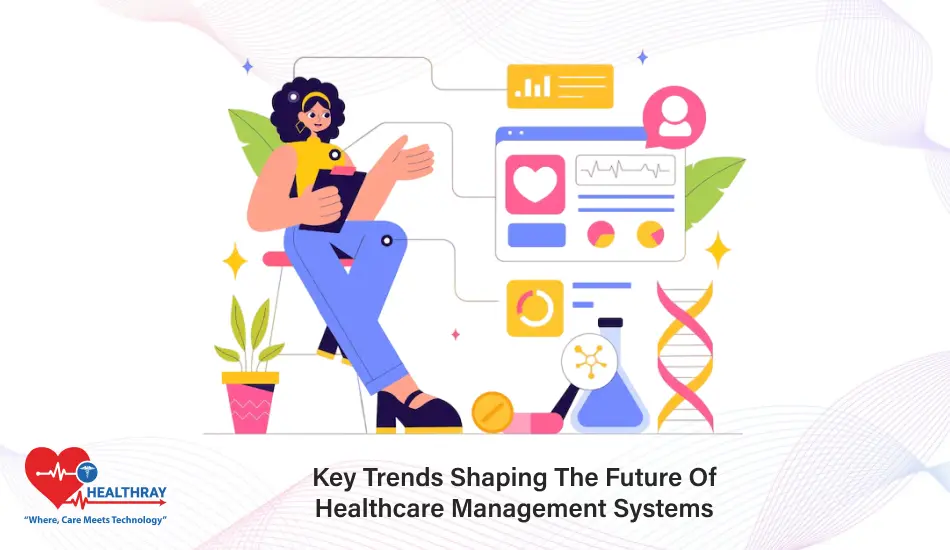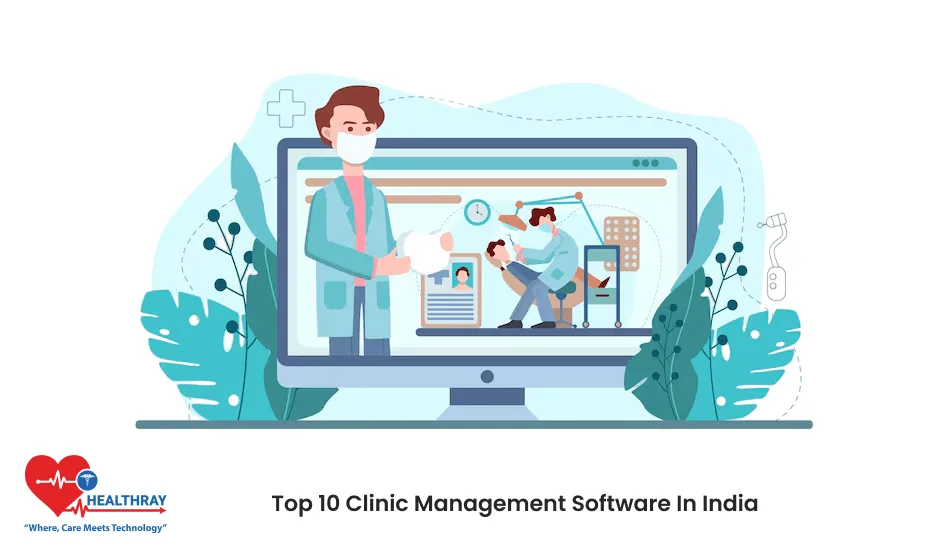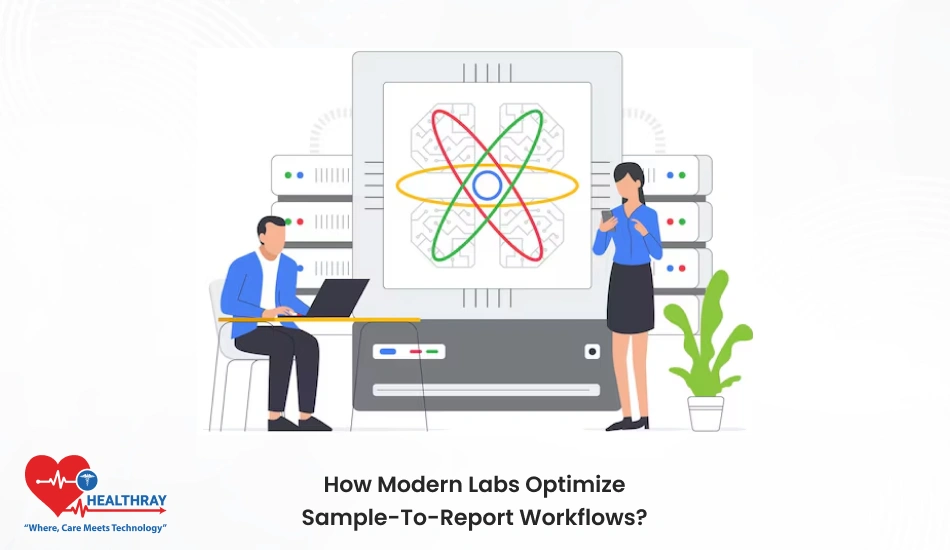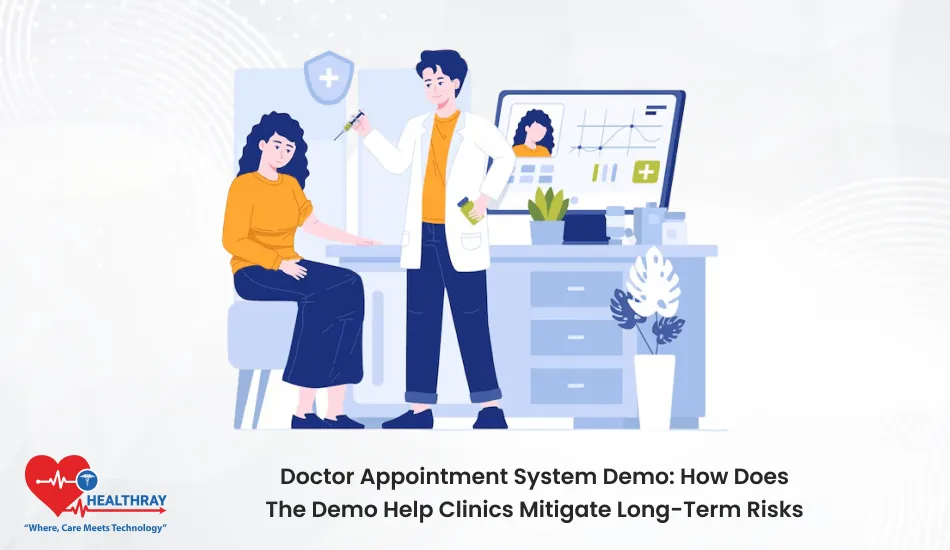Essentially, the future of healthcare management remains rooted in technology and data-driven solutions. The rapid evolution of hospital information management systems, enhanced by AI, big data, telemedicine, and value-based care models, offers customers of these novel products some possible solutions to already-present problems, such as high costs, workforce shortages, and patient demands for individualized care.
To be future-proof, hospitals, clinics, doctors, and healthcare workers must adhere to this trend and realize its success in their daily activities. It’s all about creating a place for both patients and healthcare workers to thrive-not just ability.
The present article outlines the six main trends affecting the future of management system design and their impact on the healthcare community. Learn how these could work to improve efficiencies, reduce costs, and provide improved patient outcomes: What are the prospects for the future in terms of healthcare professionals and organizations?
AI and Automation Trend In Healthcare Management
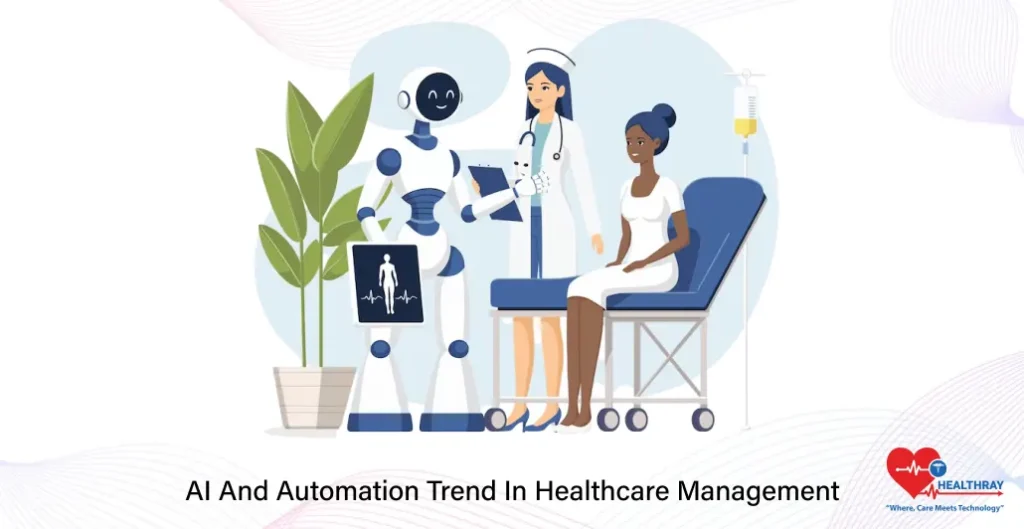
Artificial Intelligence and automation are futuristic sounding terms that have become a reality while they are transforming healthcare management today. AI-driven solutions allow for enhanced efficiency in new hospitals and clinics by streamlining administrative responsibilities for better health outcomes for patients. How is this in reality for health practitioners?
1.1 Clinical Applications of AI
AI is doing wonders in the clinical environments; it can analyze medical data much faster and much more accurately than humans could. To give an example, AI assists in diagnostic imaging by pointing towards areas during routine scans that otherwise would probably get missed.
This does not take away anything from the healthcare practitioners that are learning about this process, but it actually helps them to make informed decisions faster and spend more time on patient care: AI handles data analysis.
The opposite side is predictive analytics. AI systems have been able to predict patient need-from predicting admissions to patients needing more intensive care to monitoring those that need more intensive care. This helps in better resource allocation by institutions thus avoiding overcrowding at hospitals or clinics.
1.2 Automation in Administrative Work
Automation is impacting the administrative side of health care more than it is the clinical side. Appointment schedules, patient record updates, and billing, all of which were previously time-consuming tasks on the administrative side, are now automated, thereby saving precious time for healthcare staff.
The other implication is that such mechanisms will prevent human error, speed things up, and provide the administrative team with time to concentrate on complex non-repetitive tasks requiring human intervention.
Automation will also apply to supply chain managers, and it will help hospitals avoid stock-outs of critical medical supplies. It will keep stock levels low and will automatically generate a reorder so that the practitioners treating patients will not run a shortage of anything that they always require.
1.3 Improving Patient Experience
AI benefits not only doctors and nurses but actually contributes to improving the patient’s experience. AI will make it possible to provide personalized health services and even more individualized and therefore treatment-focused therapies that will yield greater success rates and better patient outcomes as a result of better consideration of his personal history, lifestyle, and genetics.
For instance, many hospitals are now deploying AI chatbots in assisting patients to schedule appointments, answer general inquiries, and eventually even manage post-treatment follow-ups. Since these chatbots are all online and working round-the-clock, they can respond fast and useful, which means patients need not waste their time waiting on hold or in long lines to get information regarding their appointments.
1.4 Reduced Caregiver Burnout
Probably the most significant merit of AI and automation is that these reduce the burden put on the healthcare personnel instead. Thanks to automation of menial and repetitive tasks, healthcare workers can now return their efforts towards more meaningful interactions at the point of care. This will help reduce burnout-an issue that severely plagues the industry-as doctors and nurses find it hard to cope with the elevated stress levels they encounter in the day to day.
Through the transition into AI and automation, the hospitals and clinics are not merely investing in technology; they are investing in the welfare of their personnel. Care delivery is being transformed through the trend, enabling healthcare service providers to enhance and fine-tune their aptitudes in the core of their occupations: that is, treating humans.
The Growth of Telehealth and Distributed Care
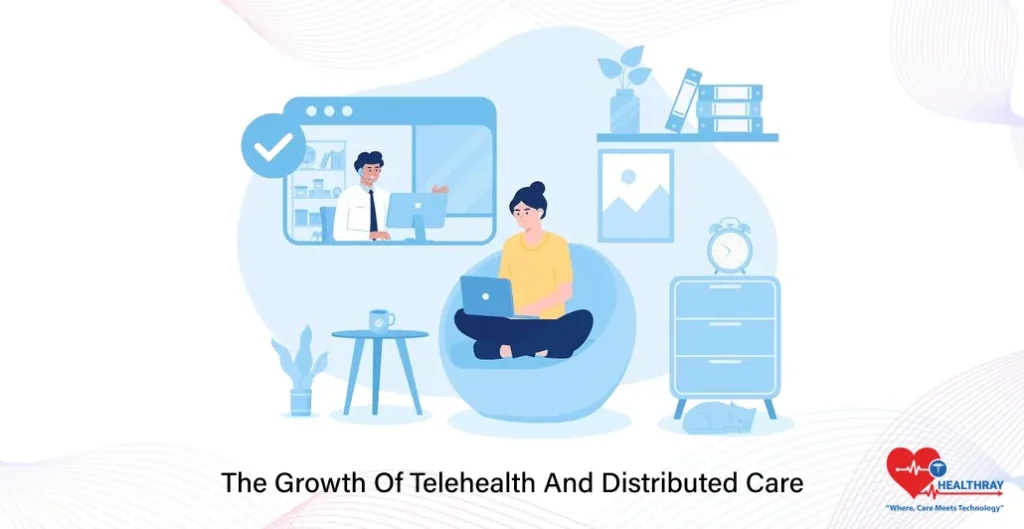
Among the trending topics nowadays is Telehealth. Once dismissed as secondary to real healthcare, telehealth has evolved to be a pillar of modern healthcare management. From an element of telehealth that was once limited to providing care during the COVID-19 pandemic, it is now considered the main way for many patients to receive care and for many health professionals to provide care. The flexibility and accessibility telehealth offers in configuring how care is provided is revolutionizing care, inching toward obsolescence of the in-person appointment model.
2.1 Telehealth As A New Standard of Care
Through telehealth, health professionals may reach out to their patients almost anywhere, increasing access to care for those who may have difficulty reaching a clinic or hospital. Now, patients far away from cities or having trouble moving can contact specialists who were not accessible to them before. Most importantly, telehealth brings about access equality into health systems.
Not only does it benefit the patient, but telehealth is also very convenient for healthcare workers. It allows doctors to take care of patients or keep track of their attendance more efficiently, letting them manage more cases without their actual presence on hospital grounds. This means routine follow-up and consultation for a nurse or RMO (Resident Medical Officer) without putting the additional burden on already crowded physical facilities.
2.2 Distributed Care: Grows Beyond the Walls of the Hospital
Telehealth is the process of extending health services into the categories that lie outside health facilities. In line with this future trend of hospital management systems, some of the healthcare services would be provided at the patient’s home or outside the walls of the hospitals. The cities and hospitals would be relieved from the burden of patient care and, especially, patient-centric ‘healthcare’.
Distributed care examples can include home monitoring devices that allow patients to monitor their vitals and submit them to their health providers. This would result in diabetes and heart patients being managed from afar since physicians have real-time access to health parameters. Interventions can be faster, direct, and without many visits to the hospital.
Mobile health clinics are other characteristics of distributed care, which introduce health services closer to underserved communities. They travel to these areas, whether remote and impoverished, to provide vaccination, primary check-up, and diagnostics. The result will be the provision of healthcare access to patients who would otherwise lack access to health services.
2.3 Improving Access and Cost Savings
Telehealth and distributed care have emerged as two of the most exciting phenomena of healthcare-the attainment of cost savings at the patient level and health systems. Usually, patients spend less on transportation or time, while health facilities expend fewer resources on in-person visits-exceptions apply. Hospitals and clinics benefit from telehealth because they consume less space and produce fewer tangible materials.
This would keep the infection possibilities linked to health care at bay. More patients would avoid the hospital and, consequently, their chances of acquiring an infection would reduce. Most importantly, such is critical for those vulnerable patients, such as the elderly or immunocompromised.
2.4 Challenges Associated With Telehealth And Distributional Care
It is an incontrovertible law, however, that with great benefits come great challenges. Among the challenges that these systems face is that not all patients are educated enough to use these technologies; hence, they come into difficulty in using the telehealth platform. It has also been raised as security concerns since patient information will be transported through the Internet. Therefore, hospitals and clinics will have to invest more in robust security apparatus for keeping that patient confidentiality intact.
It is possible that some people will not be able to access telehealth or e-services, just like the last idea mentioned. So, equal access will be the problem that telehealth and distribution care will face to function well for the delivery of their services.
2.5 The Future of Telehealth
Telehealth is here to remain. It will become even more integrated with advancing technology over the years. These innovations are anticipated to render telehealth ever more potent tools in the hands of medical doctors, nurses, and all allied health professionals: virtual reality consultations, AI-powered diagnostics, and increasingly sophisticated monitoring tools.
Ultimately, telehealth and distributed care will underpin the core of future management of health systems. Though quite burdened, it provides accessible, flexible, and cost-effective care to the patient. However, these should be resolved by the health provider to fully benefit them.
Transforming into Value Base Care Models
Fee-for-service fees would be generally changing into value-based care within the health systems quite gradually, with these changes beginning to be viewed across the health institutions-from hospitals to clinics and health care practitioners -internally as myths among patients. Patients are not paid per number of services that a health care provider delivers, but on quality in value-based care, efficient care delivery. Hence, value-based care would eventually lead to better results for patients, lower cost of care, and, in the long run, sustainability of the system.
3.1 What value-based care implies to the parties concerned.
At best, value-based care would mean a patient-centered focus instead of a service-centered view on patient outcomes. Healthcare providers would thus be incentivized to provide treatments and interventions leading to the best long-term health outcomes for their patients. These systems will improve prevention or better management of conditions so that hospitalizations or complications, with their related costs, are avoided.
In summary, success for any health provider is measured in terms of quality of care, patient satisfaction, and improvement of health achieved by patients. All these would thus encourage personalized, efficient, and holistic care from hospitals and clinics.
3.2 Impact Value-Based Care Has on Providers
The behavior of doctors, nurses, and health institutions have to be modified as such conversion takes place. The trend in present-day service requirements was to see as many patients as possible or perform as many procedures as possible. However, now, the health care professions must intervene in improving the general health condition of their patients.
That might, indeed, incentivize putting into practice preventive strategies that concentrate on early detection and management of disease and chronic conditions. For example, if a doctor spent a considerable time counseling a diabetic patient on self-management of their condition to stave off future complications, it would ultimately benefit their clinic or hospital by saving on emergency interventions while holding the patient’s health stable over time.
3.3 Cost-saving and Efficiency
It is a very strong driver for value-based care is the need to control insatiable costs in the healthcare industry. One other boon on sustainable value-based care with ever-increasing healthcare costs is on preventive and minimization of unnecessary treatments. Reduce unneeded hospital visits and clinic treatments whereby procedures that do not succeed in improving the health of the patient thus save any expenditure forthcoming and unnecessary for such cases.
The treatment will spare many tests and, instead of sending off, get a patient to consent to what is needed for him.
These savings are truly minimal considering the amount of damage that sometimes arises from overtreatment.
3.4 Benefits for Patients
Patient-based care will be something big for the patient. This model will provide personalised and coordinated health care that equates to the total well-being of the patient. Hence, in consequence, patients become active in the management of their own health, thus attaining successful health outcomes.
More often than not, patients will receive the right care at the right time so that they become spared from emergency room visits and hospital readmissions. Value-based care ensures appropriate ongoing care to a patient diagnosed with a chronic disease such as heart disease or diabetes so that such diseases can be prevented from progressing.
3.5 The Implementation Challenges of Value-Based Care
Much benefits thus accrue as regards managing value-based care, and yet its implementation is also met by some challenges for the considered care model. For the providers of health care or the institutions, the very idea of working through the change from the fee-for-service current model to one that is value-based is one of complexities. It demands a cultural transformation and a change in the perception among the attending physicians and their staff away from quality metric- and quantity-based.
It must face logistical challenges as well. By far, the most efficient determinant for the follow-up of patient outcome assessment is data collection and analyses. Data collection and performance measurement will require a considerable infusion of technology and the training of key personnel for monitoring patient progress.
Another one that will count in the challenge discussion is engaging the patient. Whatever value-based care would work for would require a direct engagement of patients with their health management. All of the healthcare givers should follow educating patients and having appropriate resources about keeping them engaged in their own treatment plans.
3.6 The Future of Value-Based Care
The smart money is now on value-based care models being aggressively embraced by an increasing number of health care providers and institutions. Step by step, the ways by which health care systems render services are becoming patient-centered and cost-efficient. These hospitals and clinics will realize that they are facilitating even better patient outcomes while being more efficient and also frequently sustainable.
Quality patient-center health care in the future, however, will minimize managing symptoms without resolving their source of the health problem. Given the extent to which value-based care is embedded in this continuum of change, we should expect a rise in its acceptance in medical practice in the years to come.
Conclusion
The future of healthcare management is defined by a combination of technical innovations and changing patient needs. AI and automation drive this transformation in the health systems with telehealth. From the views intrinsic to a doctor, nurse, RMO, and medical administrator, it is by bringing together these changing forces that much better patient outcomes will be realized simultaneously with improvements in operational efficiency and reductions in costs.
Thus, each of these identified trends has its opportunities and hurdles. AI and automation will help ease the burden on healthcare personnel, but technology and training will, equally, be solicited. Telehealth and distributed care provide greater access to care but the promise is accompanied with challenges such as the digital divide. Value-based care models are all about introducing outcomes over volume but therein lies a difficult balancing act with the challenges of data management and patient engagement.
